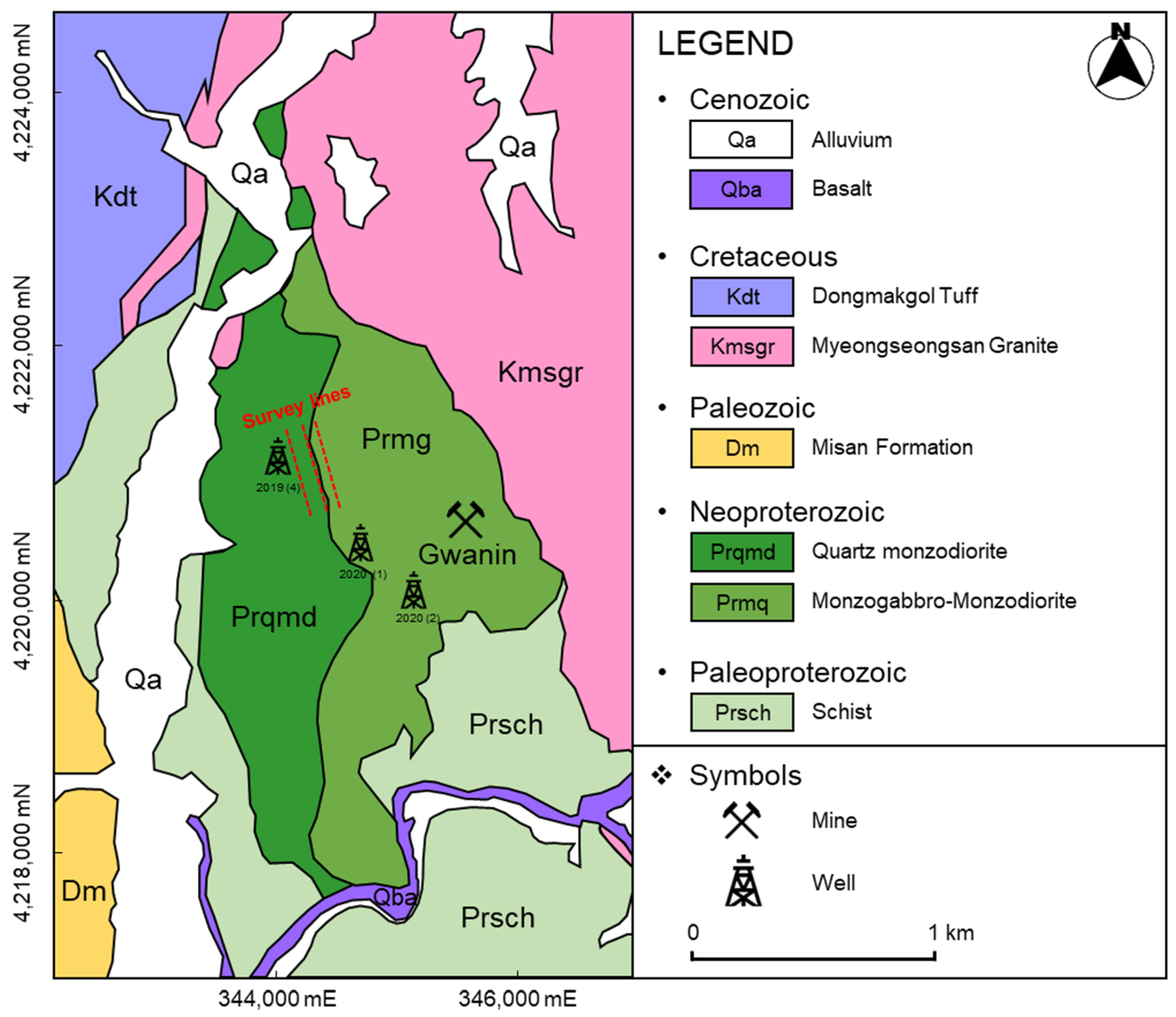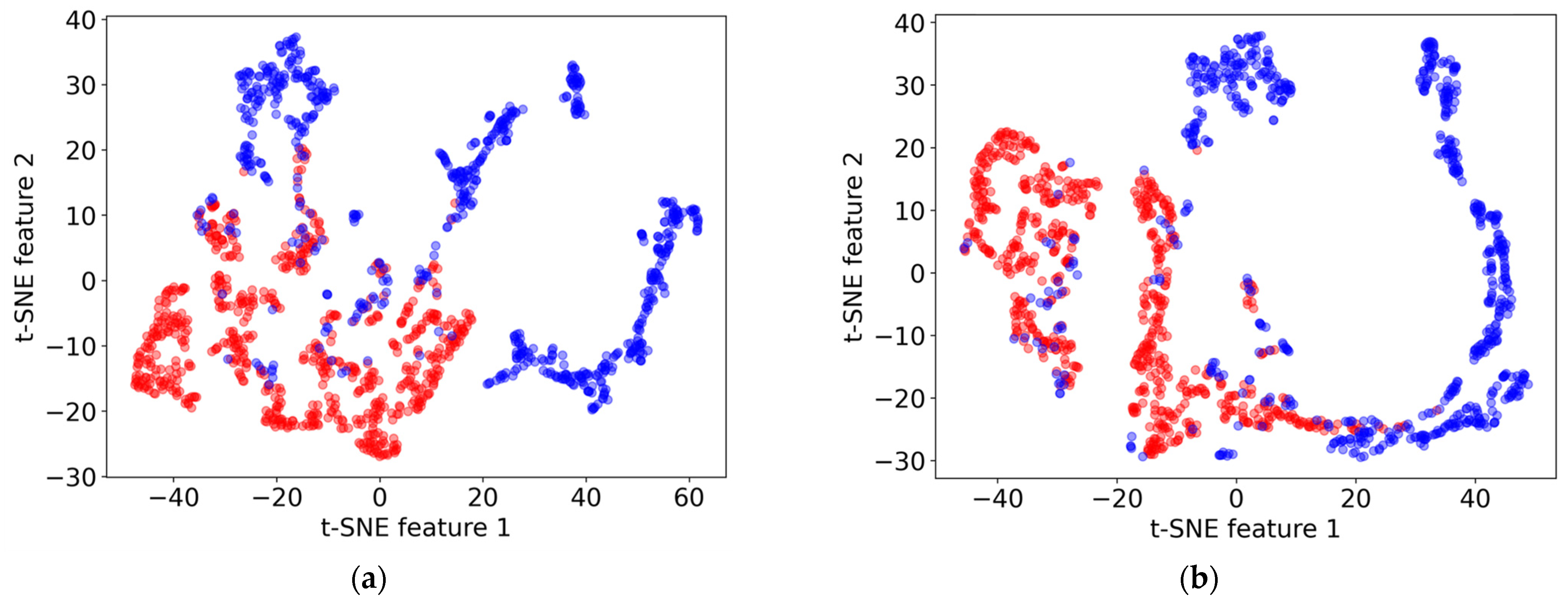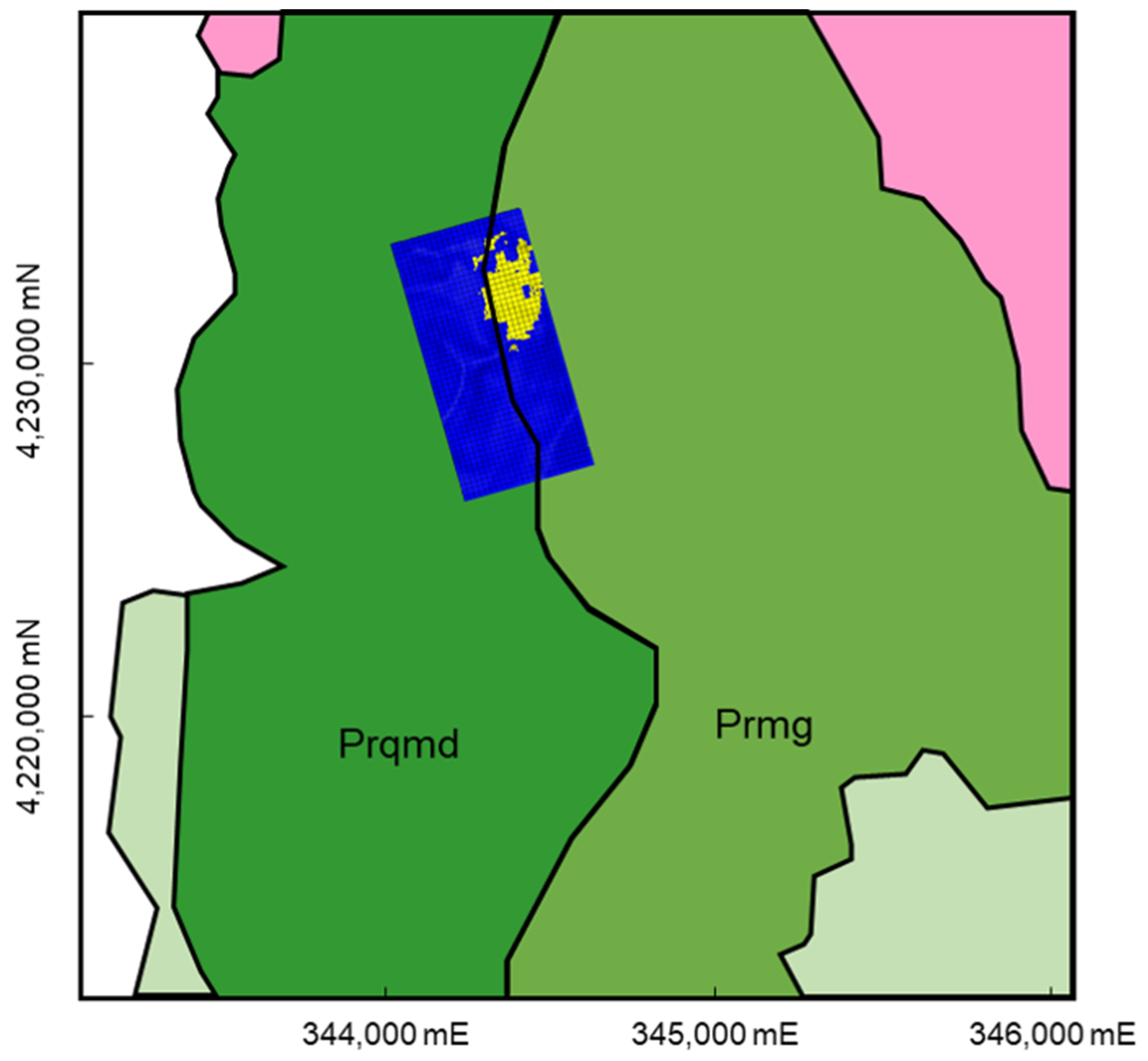Domain Adaptation from Drilling to Geophysical Data for Mineral Exploration
Abstract
:1. Introduction
2. Data Acquisition and Preliminary Analysis
2.1. Study Area (Pocheon, Republic of Korea)

2.2. Geophysical Survey Implementation
2.3. Drilling Operations and Laboratory Experiment
2.4. Preliminary Analysis
3. Methods
3.1. Overview of Domain Adaptation Techniques
- Feature-based adaptation: This approach aligns the feature spaces of the source and target domains to minimize domain differences, ensuring that models perform consistently across both. The principle involves transforming or finding common representations of features that reduce discrepancies. Representative methods include Transfer Component Analysis (TCA) [23] and Deep Correlation Alignment (Deep CORAL) [24].
- Adversarial-based adaptation: Inspired by adversarial training, this strategy trains models to produce features that a domain classifier cannot distinguish between do-mains, promoting domain-invariant feature generation. Key techniques are Domain-Adversarial Neural Networks (DANNs) [25], Conditional Domain Adversarial Networks (CDANs) [26], and Adversarial Discriminative Domain Adaptation (ADDA) [27].
- Discrepancy-based adaptation: Focusing on directly minimizing statistical differences in feature distributions between domains, this method aims to bridge the gap by adjusting model representations. Techniques such as Maximum Classifier Discrepancy (MCD) [28] and Kernel Mean Matching (KMM) [29] are utilized to achieve this goal.
3.2. Domain Adaptation in Geophysics
3.3. Implementation of Domain Adaptation
4. Results
5. Discussion
5.1. Properties of Drilling and Geophysical Data
5.2. Evaluation of Classification Outcomes
5.3. Limitations in Data and Techniques
6. Conclusions
Funding
Data Availability Statement
Acknowledgments
Conflicts of Interest
References
- Wang, S.; Liu, H.; Li, L.; Zhang, C. Editorial: Geological disasters and its prevention in deep mining. Front. Earth Sci. 2022, 10, 1071841. [Google Scholar] [CrossRef]
- Xie, H.; Ju, Y.; Gao, F.; Gao, M.; Zhang, R. Groundbreaking theoretical and technical conceptualization of fluidized mining of deep underground solid mineral resources. Tunn. Undergr. Space Technol. 2017, 67, 68–70. [Google Scholar] [CrossRef]
- Bergen, K.; Johnson, P.; Hoop, M.; Beroza, G. Machine learning for data-driven discovery in solid Earth geoscience. Science 2019, 363, eaau0323. [Google Scholar] [CrossRef]
- Rodriguez-Galiano, V.; Sánchez-Castillo, M.; Chica-Olmo, M.; Chica-Rivas, M. Machine learning predictive models for mineral prospectivity: An evaluation of neural networks, random forest, regression trees and support vector machines. Ore Geol. Rev. 2015, 71, 804–818. [Google Scholar] [CrossRef]
- Chaudhari, A.; Khandelwal, H.; Khan, A.; Kurade, O.; Kolekar, A. Mineral Prediction Using Random Forest Classifier. In Proceedings of the 14th International Conference on Computing Communication and Networking Technologies (ICCCNT), Delhi, India, 6–8 July 2023; IEEE: Piscataway, NJ, USA, 2023; pp. 1–6. [Google Scholar] [CrossRef]
- Ford, A. Practical Implementation of Random Forest-Based Mineral Potential Mapping for Porphyry Cu–Au Mineralization in the Eastern Lachlan Orogen, NSW, Australia. Nat. Resour. Res. 2019, 29, 267–283. [Google Scholar] [CrossRef]
- Carranza, E.; Laborte, A. Data-Driven Predictive Modeling of Mineral Prospectivity Using Random Forests: A Case Study in Catanduanes Island (Philippines). Nat. Resour. Res. 2016, 25, 35–50. [Google Scholar] [CrossRef]
- Breiman, L. Random forests. Mach. Learn. 2001, 45, 5–32. [Google Scholar] [CrossRef]
- Chen, T.; Guestrin, C. XGBoost: A Scalable Tree Boosting System. In Proceedings of the 22nd ACM SIGKDD International Conference on Knowledge Discovery and Data Mining, New York, NY, USA, 13–17 August 2016; pp. 785–794. [Google Scholar] [CrossRef]
- Ke, G.; Meng, Q.; Finley, T.; Wang, T.; Chen, W.; Ma, W.; Ye, Q.; Liu, T.Y. LightGBM: A highly efficient gradient boosting decision tree. Adv. Neural Inf. Process. Syst. 2017, 30, 3146–3154. Available online: https://dl.acm.org/doi/10.5555/3294996.3295074 (accessed on 2 July 2024).
- Zheng, Y.; Deng, H.; Wu, J.; Wang, R.; Liu, Z.; Wu, L.; Mao, X.; Chen, J. Space-associated domain adaptation for three-dimensional mineral prospectivity modeling. Int. J. Digit. Earth 2023, 16, 2885–2911. [Google Scholar] [CrossRef]
- Shin, S.; Cho, S.; Kim, E.; Lee, J. Geophysical Properties of Precambrian Igneous Rocks in the Gwanin Vanadiferous Titanomagnetite Deposit, Korea. Minerals 2021, 11, 1031. [Google Scholar] [CrossRef]
- Lee, J.; Yang, S.; White, N.C.; Shin, D.; Kim, E.J. Whole-rock geochemistry and mineral compositions of gabbroic rocks and the associated Fe–Ti (–V) oxide deposit in the Gonamsan intrusion, South Korea. Ore Geol. Rev. 2022, 148, 105054. [Google Scholar] [CrossRef]
- Kee, W.S.; Cho, D.L.; Kim, B.C.; Jin, K.M. Geological Report of the Pocheon Sheet (1:50,000); Korea Institute of Geoscience and Mineral Resources: Daejeon, Republic of Korea, 2005; p. 66. [Google Scholar]
- Shin, Y.; Shin, S. Rock classification in a vanadiferous titanomagnetite deposit based on supervised machine learning. Minerals 2022, 12, 461. [Google Scholar] [CrossRef]
- Son, J.-S.; Shin, S.; Park, S.-G. Development of Three-dimensional Inversion Algorithm of Complex Resistivity Method. Geophys. Explor. 2021, 24, 180–193. [Google Scholar] [CrossRef]
- Kim, B.; Jeong, S.; Bang, E.; Shin, S.; Cho, S. Investigation of iron ore mineral distribution using aero-magnetic exploration techniques: Case study at Pocheon, Korea. Minerals 2021, 11, 665. [Google Scholar] [CrossRef]
- Telford, W.M.; Geldart, L.P.; Sheriff, R.E. Applied Geophysics; Cambridge University Press: Cambridge, UK, 1990. [Google Scholar]
- Feng, C.; Wang, H.; Lu, N.; Chen, T.; He, H.; Tu, X.M. Log-transformation and its implications for data analysis. Shanghai Arch. Psychiatry 2014, 26, 105–109. [Google Scholar]
- He, H.; Bai, Y.; Garcia, E.A.; Li, S. ADASYN: Adaptive synthetic sampling approach for imbalanced learning. In Proceedings of the 2008 IEEE International Joint Conference on Neural Networks (IEEE World Congress on Computational Intelligence), Hong Kong, China, 1–6 June 2008; pp. 1322–1328. [Google Scholar]
- Tang, B.; He, H. KernelADASYN: Kernel based adaptive synthetic data generation for imbalanced learning. In Proceedings of the 2015 IEEE Congress on Evolutionary Computation (CEC), Sendai, Japan, 25–28 May 2015; pp. 664–671. [Google Scholar] [CrossRef]
- Wang, Z.; Du, B.; Guo, Y. Domain Adaptation with Neural Embedding Matching. IEEE Trans. Neural Netw. Learn. Syst. 2020, 31, 2387–2397. [Google Scholar] [CrossRef]
- Pan, S.J.; Tsang, I.W.; Kwok, J.T.; Yang, Q. Domain adaptation via transfer component analysis. IEEE Trans. Neural Netw. 2009, 22, 199–210. [Google Scholar] [CrossRef]
- Sun, B.; Saenko, K. Deep CORAL: Correlation alignment for deep domain adaptation. In Proceedings of the European Conference on Computer Vision (ECCV) Workshops, Amsterdam, The Netherlands, 11–14 October 2016; pp. 443–450. [Google Scholar] [CrossRef]
- Ganin, Y.; Lempitsky, V. Unsupervised domain adaptation by backpropagation. In Proceedings of the 32nd International Conference on Machine Learning (ICML), Lille, France, 6–11 July 2015; pp. 1180–1189. [Google Scholar]
- Long, M.; Cao, Z.; Wang, J.; Jordan, M.I. Conditional adversarial domain adaptation. In Proceedings of the Advances in Neural Information Processing Systems (NeurIPS), Montreal, QC, Canada, 3–8 December 2018; pp. 1640–1650. [Google Scholar] [CrossRef]
- Tzeng, E.; Hoffman, J.; Saenko, K.; Darrell, T. Adversarial discriminative domain adaptation. In Proceedings of the IEEE Conference on Computer Vision and Pattern Recognition (CVPR), Honolulu, HI, USA, 21–26 July 2017; pp. 7167–7176. [Google Scholar] [CrossRef]
- Saito, K.; Watanabe, K.; Ushiku, Y.; Harada, T. Maximum classifier discrepancy for unsupervised domain adaptation. In Proceedings of the IEEE Conference on Computer Vision and Pattern Recognition (CVPR), Salt Lake City, UT, USA, 18–22 June 2018; pp. 3723–3732. [Google Scholar] [CrossRef]
- Huang, J.; Gretton, A.; Borgwardt, K.; Schölkopf, B.; Smola, A.J. Correcting sample selection bias by unlabeled data. In Proceedings of the Neural Information Processing Systems, Vancouver, BC, Canada, 4–7 December 2006. [Google Scholar]
- Pan, S.J.; Yang, Q. A survey on transfer learning. IEEE Trans. Knowl. Data Eng. 2010, 22, 1345–1359. [Google Scholar] [CrossRef]
- Glorot, X.; Bordes, A.; Bengio, Y. Domain adaptation for large-scale sentiment classification: A deep learning approach. In Proceedings of the 28th International Conference on Machine Learning (ICML-11), Bellevue, WA, USA, 28 June–2 July 2011; pp. 513–520. [Google Scholar]
- Long, M.; Cao, Y.; Wang, J.; Jordan, M.I. Learning transferable features with deep adaptation networks. In Proceedings of the International Conference on Machine Learning, Lille, France, 6–11 July 2015; pp. 97–105. [Google Scholar]
- Wang, Z.; Wang, X.; Liu, F.; Gao, P.; Ni, Y. Adaptative balanced distribution for domain adaptation with strong alignment. IEEE Access 2021, 9, 100665–100676. [Google Scholar] [CrossRef]
- Mathelin, A.; Atiq, M.; Richard, G.; de la Concha, A.; Yachouti, M.; Deheeger, F.; Vayatis, N. Adapt: Awesome domain adaptation python toolbox. arXiv 2021, arXiv:2107.03049. [Google Scholar] [CrossRef]
- Shahapure, K.R.; Nicholas, C.K. Cluster Quality Analysis Using Silhouette Score. In Proceedings of the 2020 IEEE 7th International Conference on Data Science and Advanced Analytics (DSAA), Sydney, Australia, 6–9 October 2020; pp. 1322–1328. [Google Scholar] [CrossRef]
- Van Der Maaten, L. Barnes-hut-SNE. arXiv 2013, arXiv:1301.3342. [Google Scholar] [CrossRef]
- Zheng, W.; Lai, D.; Gould, K.L. A simulation study of a class of nonparametric test statistics: A close look of empirical distribution function-based tests. Commun. Stat. Simul. Comput. 2023, 52, 1132–1148. [Google Scholar] [CrossRef]







| Model | Accuracy | Recall-Score | Precision | F1 Score |
|---|---|---|---|---|
| RF | 0.954 | 0.956 | 0.920 | 0.936 |
| DANN | 0.936 | 0.914 | 0.902 | 0.908 |
| Mean | SD | Correlations | |||
|---|---|---|---|---|---|
| LOGRESI | SQRTCHAR | LOGSI | |||
| Rock samples | |||||
| LOGRESI | 2.99 | 1.26 | 1.00 | ||
| SQRTCHAR | 12.19 | 7.40 | −0.78 | 1.00 | |
| LOGSI | −1.91 | 1.14 | −0.81 | 0.84 | 1.00 |
| Field data | |||||
| LOGRESI | 4.02 | 0.61 | 1.00 | ||
| SQRTCHAR | 2.00 | 2.25 | −0.36 | 1.00 | |
| LOGSI | −1.40 | 0.63 | −0.41 | 0.61 | 1.00 |
Disclaimer/Publisher’s Note: The statements, opinions and data contained in all publications are solely those of the individual author(s) and contributor(s) and not of MDPI and/or the editor(s). MDPI and/or the editor(s) disclaim responsibility for any injury to people or property resulting from any ideas, methods, instructions or products referred to in the content. |
© 2024 by the author. Licensee MDPI, Basel, Switzerland. This article is an open access article distributed under the terms and conditions of the Creative Commons Attribution (CC BY) license (https://creativecommons.org/licenses/by/4.0/).
Share and Cite
Shin, Y. Domain Adaptation from Drilling to Geophysical Data for Mineral Exploration. Geosciences 2024, 14, 183. https://doi.org/10.3390/geosciences14070183
Shin Y. Domain Adaptation from Drilling to Geophysical Data for Mineral Exploration. Geosciences. 2024; 14(7):183. https://doi.org/10.3390/geosciences14070183
Chicago/Turabian StyleShin, Youngjae. 2024. "Domain Adaptation from Drilling to Geophysical Data for Mineral Exploration" Geosciences 14, no. 7: 183. https://doi.org/10.3390/geosciences14070183







